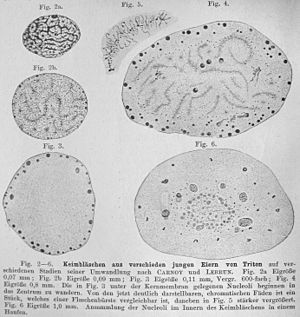Oscar Hertwig facts for kids
Quick facts for kids
Oscar Hertwig
|
|
|---|---|

Oscar Hertwig by Nicola Perscheid
|
|
| Born | 21 April 1849 Friedberg, Hesse
|
| Died | 25 October 1922 (aged 73) |
| Nationality | German |
| Known for | Study of protists |
| Scientific career | |
| Fields | Zoology |
Oscar Hertwig (born April 21, 1849, in Friedberg – died October 25, 1922, in Berlin) was a German scientist. He studied how living things develop (called embryology) and animals (called zoology). He is famous for his work in developmental biology and evolution. Hertwig was the first person to see how sexual reproduction happens. He observed this by looking at the cells of sea urchins through a microscope.
About Oscar Hertwig
Oscar Hertwig had a younger brother, Richard Hertwig, who was also a famous zoologist. Both brothers learned a lot from their teacher, Ernst Haeckel, at the University of Jena. They used Haeckel's ideas to help them understand more about zoology.
Between 1879 and 1883, the brothers studied how embryos grow. They focused on the theory of the coelom. This is the fluid-filled space inside the body of many animals. Their work was based on Haeckel's ideas about how species change over time. This included the "biogenetic law" and the "gastraea theory". These theories suggested that an animal's development shows its evolutionary history.
After about ten years, the brothers moved to different parts of Germany. Oscar Hertwig became a professor of anatomy in Berlin in 1888. His brother Richard had moved earlier, becoming a zoology professor in Munich in 1885. Richard taught there for 40 years.
Discoveries in Reproduction
Oscar Hertwig was a leader in studying how animals develop. He also wrote an important textbook. He figured out that the cell nucleus plays a key role in passing down traits. He also understood how chromosomes are reduced during meiosis. This is a special type of cell division.
In 1876, Hertwig published his amazing discovery. He found that when an egg cell is fertilized, a sperm cell enters it. Another scientist, Hermann Fol, saw the same thing that year.
Hertwig also did experiments with frog eggs. He discovered the 'long axis rule', also known as the Hertwig rule. This rule explains that cells usually divide along their longest side.
Understanding Heredity
In 1885, Hertwig suggested something very important. He wrote that a substance called nuclein was responsible for both fertilization and passing on traits. We now know that nuclein is nucleic acid, specifically DNA. His idea was proven correct much later, in 1944. This happened through the Avery–MacLeod–McCarty experiment.
Oscar Hertwig was very interested in how living things develop and change over time (evolution). However, he did not agree with Charles Darwin's idea that evolution happens by chance. Hertwig wrote a book about this in 1916. Its title meant "The Origin of Organisms – a Refutation of Darwin's Theory of Chance."
In 1903, Oscar Hertwig was chosen to be a member of the Royal Swedish Academy of Sciences.
You might see Oscar Hertwig's name spelled as Oscar Hedwig in some books. For example, in "Who discovered what when" by David Ellyard. The book "The Mammalian Egg" by Austin also talks about Hertwig's work on fertilization in mammals.
Works
Oscar Hertwig wrote several important scientific books. Here are two of them:
- The Elements of Human and Vertebrate Developmental Theory: This book was a guide for students and doctors. The 5th edition was published in 1915.
- The Problem of Fertilization and the Isotropism of the Egg. A Theory of Inheritance: This paper discussed how eggs are fertilized and how traits are passed down.
See also
 In Spanish: Oscar Hertwig para niños
In Spanish: Oscar Hertwig para niños


